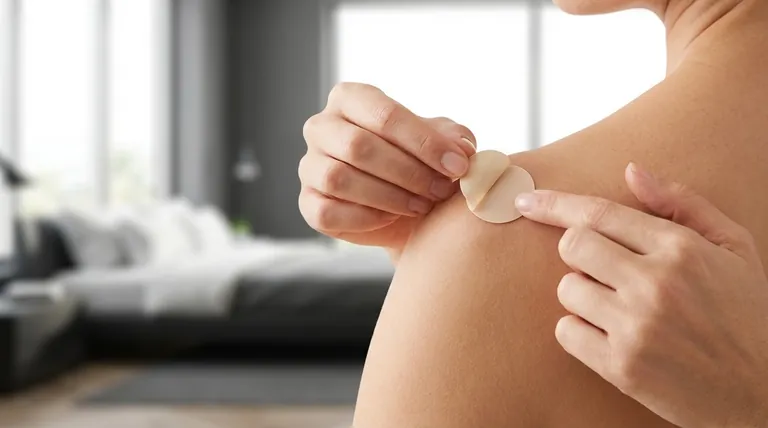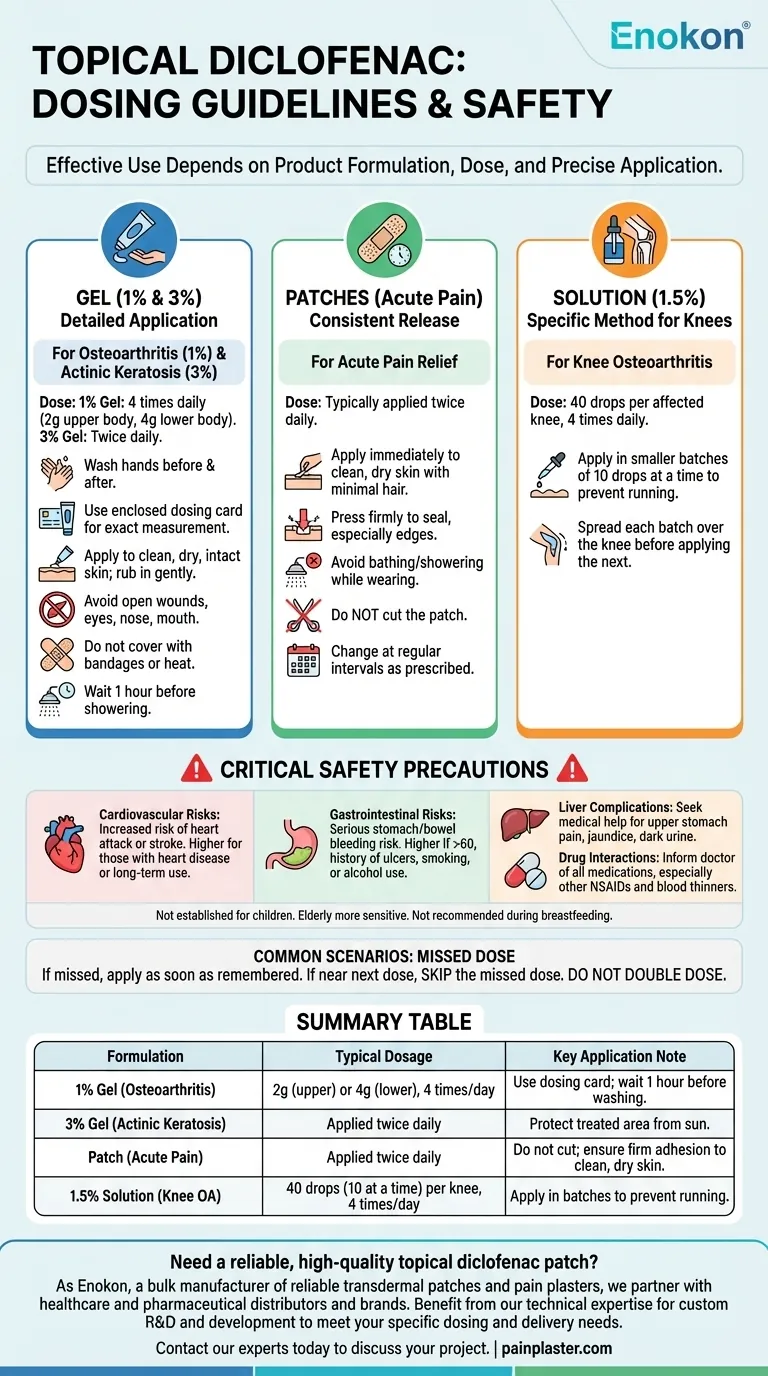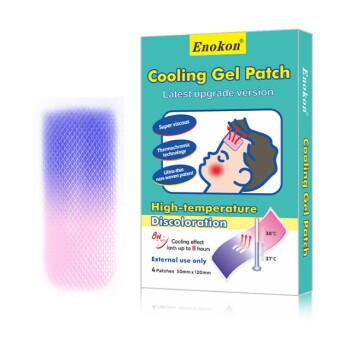The correct dosage for topical diclofenac depends entirely on the specific product formulation and the condition it is prescribed to treat. For osteoarthritis, the 1% gel is applied four times daily, using 2 grams for upper body joints like the hands or 4 grams for lower body joints like the knees. In contrast, the 3% gel for actinic keratosis is applied twice daily, and patches for acute pain are typically applied twice a day.
The most critical takeaway is that the effectiveness and safety of topical diclofenac depend not just on the dose, but on the precise application technique required for each specific form—gel, solution, or patch.

A Detailed Guide to Application by Form
Proper application is essential for ensuring the medication is absorbed correctly and for minimizing potential side effects. The method varies significantly between gels, patches, and solutions.
Applying Diclofenac Gel (1% and 3%)
The gel formulation requires careful measurement and application.
- Always wash your hands before and after applying the gel.
- Use the enclosed dosing card to measure the exact amount of gel prescribed (e.g., 2g or 4g for the 1% formulation).
- Apply the measured gel to clean, dry, and intact skin, gently rubbing it in to cover the entire affected joint or area.
- Avoid applying gel to open wounds, irritated skin, or near your eyes, nose, and mouth.
- Do not cover the treated area with bandages or apply heat unless specifically instructed by your doctor.
- Wait at least one hour before showering or washing the treated skin area to allow for full absorption.
Applying Diclofenac Patches
Patches provide a consistent, slow release of medication and require proper adhesion to work effectively.
- Apply the patch immediately after opening the pouch to clean, dry skin.
- Choose an area with minimal hair and no cuts, rashes, or irritation.
- Press the patch firmly in place, especially around the edges, to ensure it is completely sealed against the skin.
- Avoid bathing or showering while wearing the patch.
- Do not cut the patch or touch the adhesive side before application.
- Change the patch at regular intervals as prescribed, typically twice daily.
Applying Diclofenac Solution (1.5%)
The liquid solution is most commonly prescribed for knee osteoarthritis and requires a specific application method.
- For each affected knee, apply 40 drops four times per day.
- To prevent the solution from running, apply it in smaller batches of 10 drops at a time, spreading each batch over the knee before applying the next.
Understanding the Critical Safety Precautions
While topical application reduces systemic absorption compared to oral NSAIDs, significant risks still exist. It is vital to use this medication under the guidance of a healthcare professional.
Cardiovascular and Gastrointestinal Risks
Like all NSAIDs, topical diclofenac carries a warning about an increased risk of heart attack or stroke. This risk is higher for individuals with existing heart disease or those who use the medication for a long time.
There is also a risk of serious stomach or bowel bleeding. This is more likely in individuals over 60, those with a history of ulcers, or those who smoke or consume alcohol regularly.
Potential for Liver Complications
In some cases, diclofenac can cause liver problems. You should contact your doctor immediately if you experience symptoms like persistent upper stomach pain, yellowing of the skin or eyes (jaundice), or dark urine.
Important Drug Interactions
Be sure to inform your doctor of all other medications you are taking. Using topical diclofenac with other NSAIDs (oral or topical), blood thinners, or certain heart medications can increase the risk of adverse effects.
Special Considerations
The safety of topical diclofenac has not been established for children. Elderly patients may be more sensitive to its side effects, particularly kidney or stomach problems, and may require dose adjustments. Its use is generally not recommended during breastfeeding, as adequate studies on its effects are not available.
Common Scenarios and How to Handle Them
Understanding how to manage common situations like a missed dose is key to maintaining your treatment plan.
If You Miss a Dose
If you forget to apply your medication, apply it as soon as you remember.
However, if it is almost time for your next scheduled dose, skip the missed dose and return to your regular schedule. Never apply extra medication or use two patches at once to make up for a missed application.
Key Principles for Safe and Effective Use
Your approach to using topical diclofenac should be tailored to your specific treatment goal and always prioritize safety.
- If your primary focus is osteoarthritis pain relief: Be meticulous about using the dosing card for the gel and applying the medication consistently four times a day as prescribed.
- If your primary focus is acute pain relief with patches: Ensure the patch adheres completely to clean, dry skin and that you change it precisely on schedule.
- If your primary focus is treating actinic keratosis: Adhere to the twice-daily schedule for the 3% gel and be diligent about protecting the treated area from the sun.
- If your primary focus is overall safety: Discuss your complete medical history, including any heart, stomach, or liver conditions, and all other medications with your doctor before starting treatment.
Proper use of topical diclofenac requires careful attention to both the dose and the application method to maximize benefits while minimizing risks.
Summary Table:
| Formulation | Typical Dosage | Key Application Note |
|---|---|---|
| 1% Gel (Osteoarthritis) | 2g (upper body) or 4g (lower body), 4 times/day | Use enclosed dosing card; wait 1 hour before washing. |
| 3% Gel (Actinic Keratosis) | Applied twice daily | Protect treated area from sun. |
| Patch (Acute Pain) | Applied twice daily | Do not cut; ensure firm adhesion to clean, dry skin. |
| 1.5% Solution (Knee OA) | 40 drops (10 drops at a time) per knee, 4 times/day | Apply in batches to prevent running. |
Need a reliable, high-quality topical diclofenac patch?
As Enokon, a bulk manufacturer of reliable transdermal patches and pain plasters, we partner with healthcare and pharmaceutical distributors and brands. Benefit from our technical expertise for custom R&D and development to create a product that meets your specific dosing and delivery needs.
Contact our experts today to discuss your project.
Visual Guide

Related Products
- Prostate Pain Kidney Health Care Patch for Men
- Menthol Gel Pain Relief Patch
- Far Infrared Deep Heat Relief Patches Medicated Pain Relief Patches
- Lidocaine Hydrogel Pain Relief Patch for Pain Relief
- Capsaicin Chili Medicated Pain Relief Patches
People Also Ask
- What should be done in case of a testosterone patch overdose? A Step-by-Step Emergency Guide
- What should be done if a dose of testosterone patches is missed? Regain Stability and Safety
- What is the purpose of testosterone patches? A Steady Solution for Low Testosterone
- What should be done before undergoing an MRI while using testosterone patches? Remove it to prevent serious burns.
- What should be done if a testosterone patch is missed or falls off? Follow these simple timing rules for safety and consistency.















